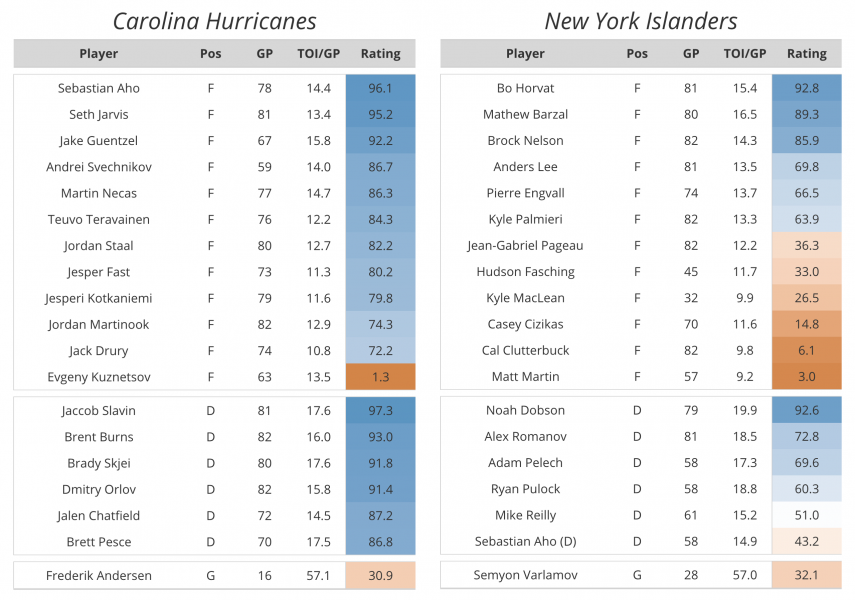Another NHL regular season is in the books, and the three of us (Josh, Luke, and Shawn) have another playoff preview for you! The ’23-24 NHL regular season was a bit strange, and we feel the first round reflects this appropriately. A few of the “expected” playoff teams fell into the chasm of bad luck or misfortune or injuries, or just wanting to make our preseason projections look bad (I’m looking at you, the Calgary Flames). The Washington Capitals made the playoffs with the worst goal differential that anyone has ever seen, and the Carolina Hurricanes get to play the New York Islanders in a hilarious series. We get to see the Toronto Maple Leafs attempt to beat the Bruins for the first time in history, watch Vancouver fans be themselves for the first time in years, and miss out on a Minnesota Wild first-round exit. Wow! I still am not quite sure where the Devils went.
Let’s get into things!
The Model
Our playoff probabilities are generated in a three step process. We use multiple models to project “future” values for all players, use these player projections to build a game probability model that projects the winning % of any given team matchup (logistic regression), and then feed these individual game probabilities into a Monte Carlo simulation that generates the probabilities for each series. In order to complete this process, each team’s player projections are aggregated into F/D/G groups, and various metrics are used for each group which are then fed into the game probability model. With these inputs, we are able to generate home and away team winning percentage values. Once we have projected all home/away probabilities for the playoff games, we prepare the simulation.
For the simulation, in a given game, we only care about the projected winning % for the home team. Take FLA/T.B. The process laid out above gives us a winning % for each team. In game 1, FLA is the home team. We replace T.B’s projected probability with a random % between 0 and 1 since they are the away team. If FLA’s projected winning % is higher than the random number, FLA “wins” that game (they “lose” if it is lower). In game 3 when T.B. is the home team, we do the same for FLA (we replace their winning % with a randomly generated %). This is done for each team game in all series and then repeated 50,000 times. Once the simulation is complete, we check how many times each team won a game, sum the total games won in a series, and arrive at each team’s projected probability.
The first step is generating multiple player-level models which produce ratings for all players in the league. For skaters, we found our xSPAR metric (Expected Standing Points Above Replacement) as well as a custom “game score” model (built using Box Score metrics) worked best for predicting future team game outcomes. Our SPAR and RAPM metrics were also tested but they did not perform quite as well for this specific task. The “game score” model we are using is similar to Dom Luszczyszyn’s Game Score model; however, we tested various box score metrics and weighted them through a “grid search” approach to optimize predicting future team game win probability.
Eastern Conference
Florida Panthers (A1) vs. Tampa Bay Lightning (WC1)
76.3% 23.7%
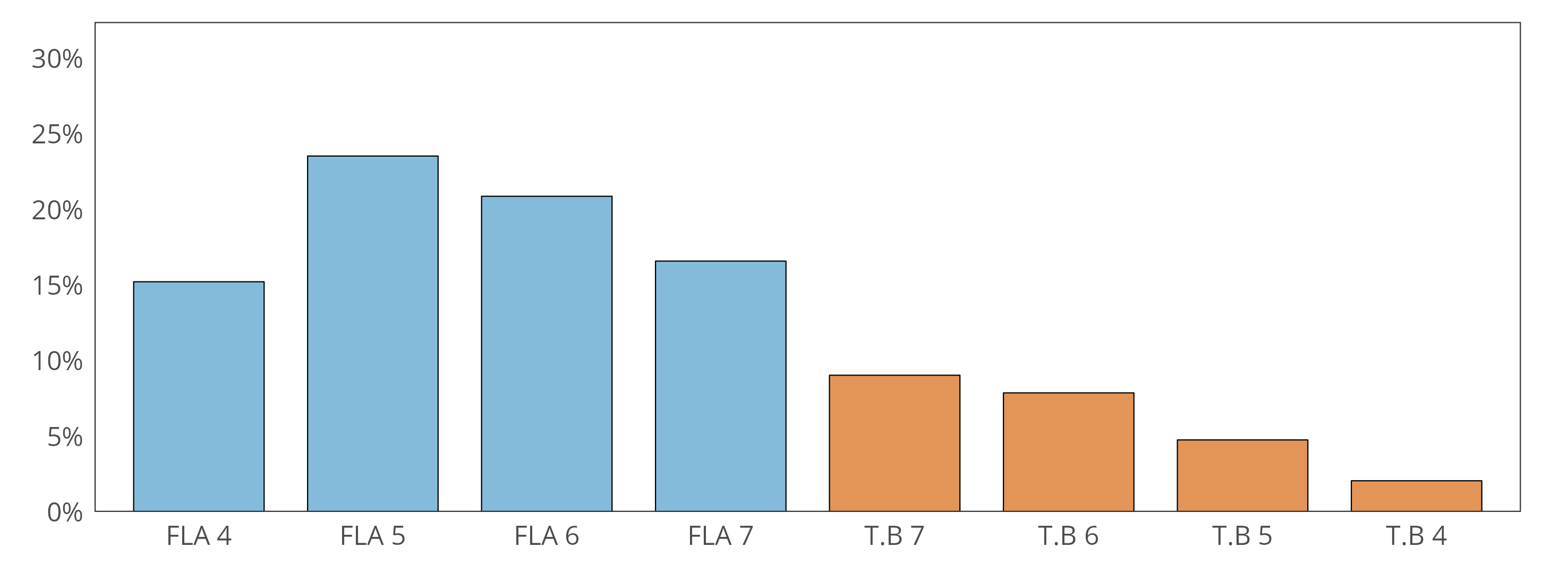

After last postseason’s run, the Panthers entered this season with much more respect. They started the year without Aaron Ekblad and Brandon Montour, but it didn’t prevent them from clinching the Atlantic Division in game 82 with a win against the Toronto Maple Leafs. The story of the year for them has been Sam Reinhart, who scored 57 goals while playing all 82 games. Combined with excellent two-way impacts, he had 6.7 SPAR and 10.8 xSPAR to go along with his box score stats. In many seasons, he’d be a true Hart contender. Unfortunately for the Panthers, Reinhart was one of the only skaters on the team who finished at a high rate. Carter Verhaeghe was the only other 30-goal scorer on the team. Mathew Tkachuk, who should be a major difference-maker for the Panthers if they make a run, finished the season with only 26 goals on 40.9 expected goals. If the Panthers can finish around league-average, they will be next to unstoppable. But if they go cold, their control of play could be wasted.
Strengths: Speed, shot volume
Weaknesses: Finishing, broadcast camera angle
Right when you thought they were out, they pull you back in. For the first time in a long time, the path to the playoffs felt a bit foggy for the Bolts heading into the season. They started the season without Andrei Vasilevskiy and made no identifiable improvements to the roster that finished third in the division n 2022-23 while others in the Atlantic Division appeared ready to make a jump. But here we are again with a Tampa Bay Lightning team that is firmly in the playoffs and does not look like a pushover, despite their wild card status. While the Lightning had less than a 50% share of goals and expected goals at 5v5 in the regular season, they were able to make up for it with their incredibly strong powerplay, led by Nikita Kucherov. Their PP% was just under 29%, making them extremely dangerous for any team that takes a penalty against them.
Strengths: Special teams, special plays, special players
Weaknesses: Controlling play at even strength
Boston Bruins (A2) vs. Toronto Maple Leafs (A3)
41.3% 58.7%
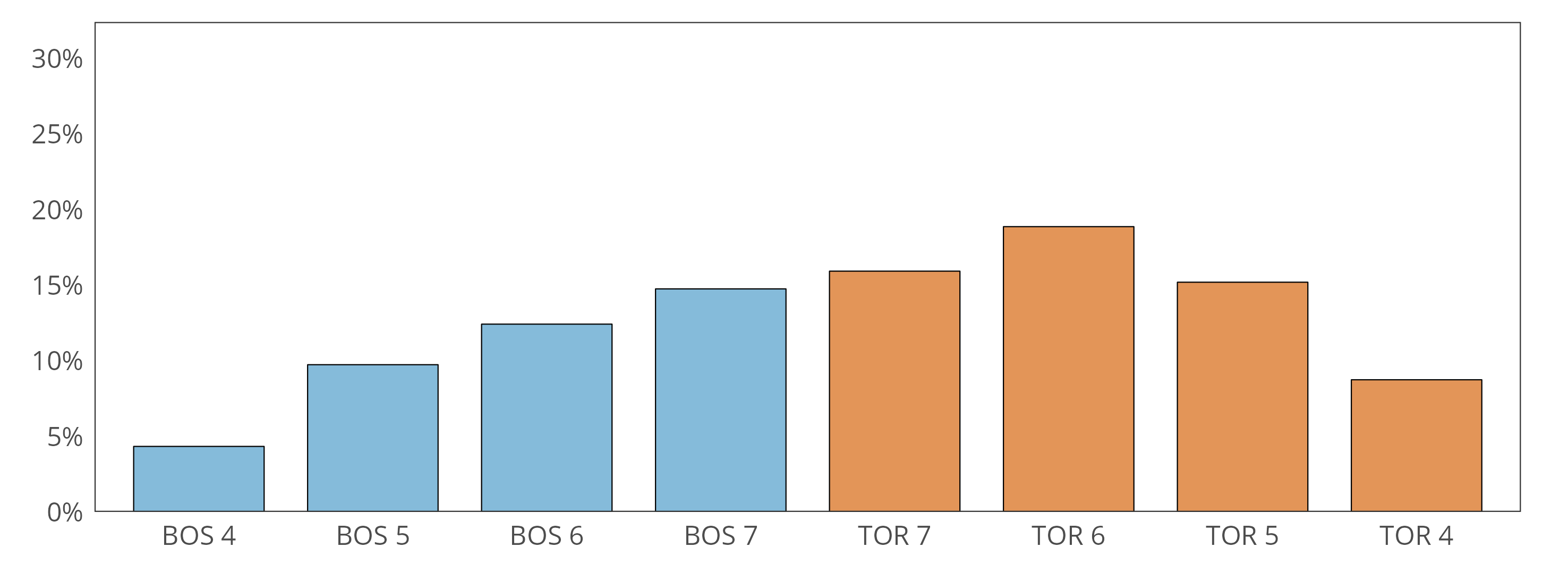
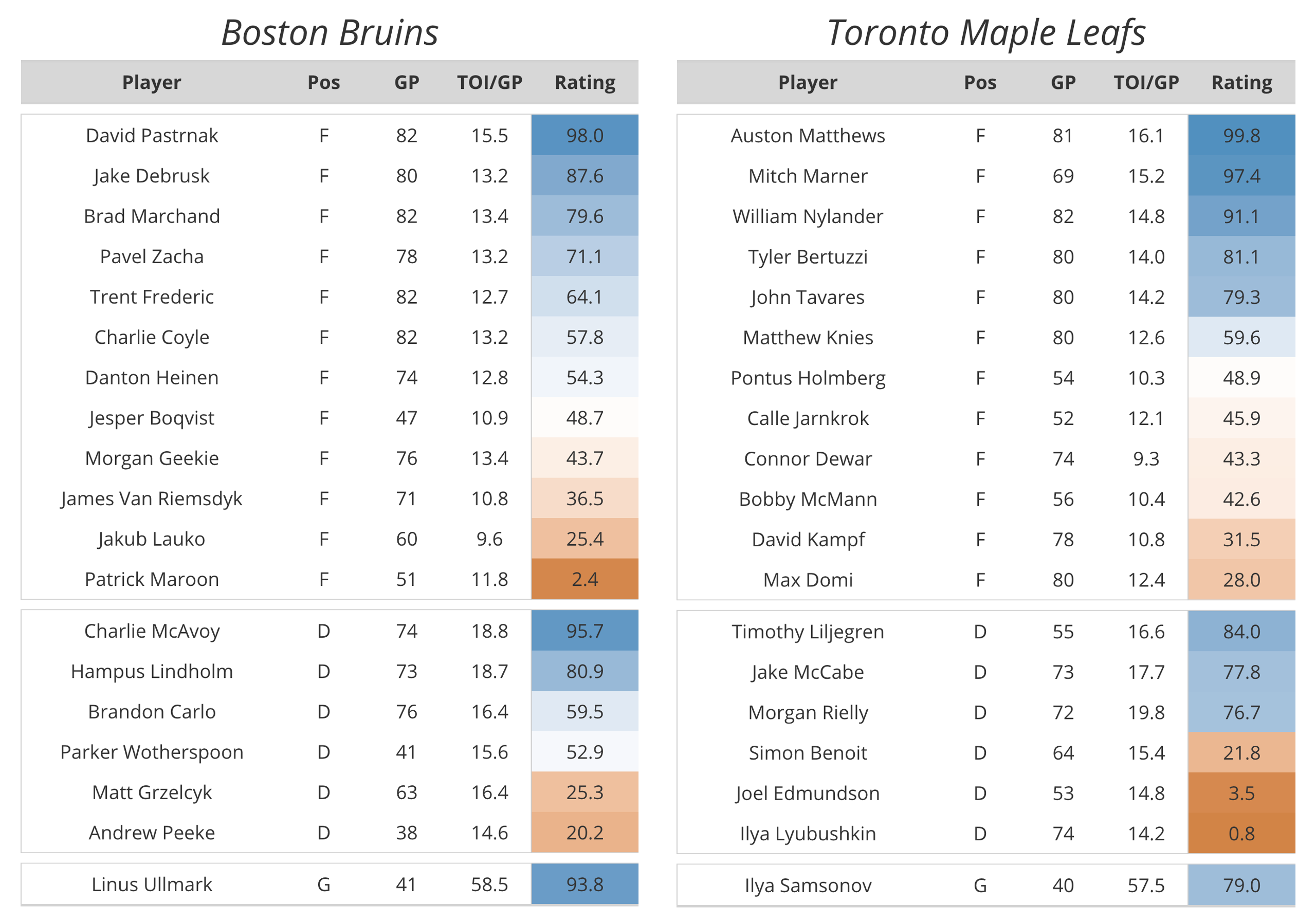
Heading into the season, the Boston Bruins were expected to regress after losing Patrice Bergeron and David Krejci to retirement and Taylor Hall to cap constraints. And while theoretically, they did regress from the NHL records for team standing points in a season, they still managed to take second place in the Atlantic. While the Bruins may be weak down the middle, they all but make up for it in goal with the best tandem in the league with Jeremy Swayman and Linus Ullmark. The two have combined for a goalie GAR of 53.3, which is 2nd in the league. After a disappointing first round exit last year, the Bruins abandoned the rotation and went with Linus Ullmark in net for games one thru six, with Swayman coming in cold for the game seven loss. This postseason, the Bruins are expected to use the rotation. Ullmark is riding a bit of a hot streak right now, likely making him the 1A.
Strengths: Goaltending, David Pastrnak
Weaknesses: Top-six centers, controlling play at even strength
The Toronto Maple Leafs went through trials and tribulations this season, and they still finished in the spot we projected in the preseason (3rd in the Atlantic). Their offseason acquisitions, which were questionable at best when they made them (John Klingberg, Max Domi, Tyler Bertuzzi, and Ryan Reaves) ended up still being quite questionable. Klingberg went on LTIR early in the season, and it took a while for the Leafs to figure out a way to make Domi and Bertuzzi work. There was also a point during the season where it felt like Ilya Samsonov was truly cursed. He was sent down to the Marlies for a stint before coming back up and being only slightly less cursed. But the story for the Leafs this season has been about one player: Auston Matthews. Not only did he end the year with 69 goals, giving fans something to follow along with along the way, he also played an extremely strong two-way game to go along with his incredible shot; he finished the season with the highest xSPAR in the RTSS era by close to a full standings point. Toronto overcame their first round curse last season over the Lightning, and now they’ll try to do it against their rival in Boston. No one believes in them, but I do (Josh wrote this on behalf of Shawn).
Strengths: Star power, powerplay
Weaknesses: Goaltending, vibes
New York Rangers (M1) vs. Washington Capitals (WC2)
85.6% 14.4%

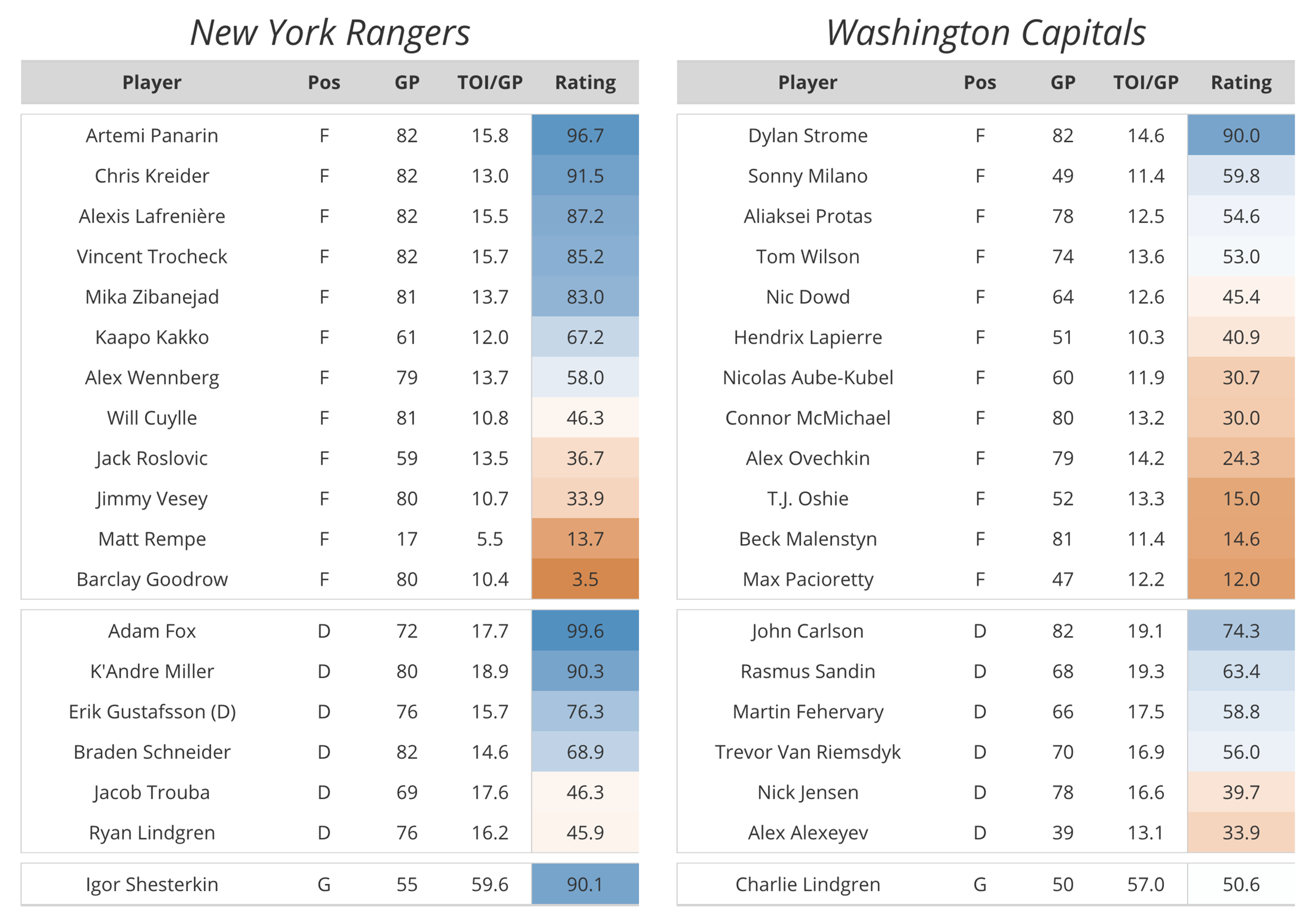
Just like the Tampa Bay Lightning, the New York Rangers are special teams merchants. A couple of years ago, we added team RAPM charts to the site, and their chart is quite telling. While they are fairly average at even strength, all of their powerplay and shorthanded impacts are between one and two standard deviations above average. With the New York market being as massive as it is, Artemi Panarin’s season certainly didn’t go under the radar, but it still feels crazy how he ultimately won’t finish top 3 in the Hart voting this season. He has the box score stats with 49 goals and 71 assists to compliment his 5.6 SPAR and 11.5 xSPAR. The Rangers also got stronger at the deadline by acquiring Alex Wennberg and Jack Roslovic to bring more depth to their forward group. They look to be in a pretty solid position heading into the first round.
Strengths: Artemi Panarin, Adam Fox
Weaknesses: Average at evens, scared of Tom Wilson
[Insert who would’ve thought meme]. That’s the preview! No, but seriously, who would’ve thought? Goal differential aside, it’s truly tough to find any strength within this team. It was a transition season this year, and by not purposely tanking, they found themselves in a playoff spot. The vibes here are immaculate. Spencer Carbery, also known as The Carburetor, has done a great job keeping the team together and motivated throughout his first season as an NHL head coach. The team all sang along to Talladega by Eric Church following their playoff clinch on Tuesday night. And have you seen Charlie Lindgren’s mustache? Look, this team just shouldn’t be here. But wouldn’t it be fun if they went on a run? They’re not going to, but it’s important to dream.
Strengths: Vibes, rays of sunshine during matinee games
Weaknesses: Like everything
Carolina Hurricanes (M2) vs. New York Islanders (M3)
90.0% 10.0%
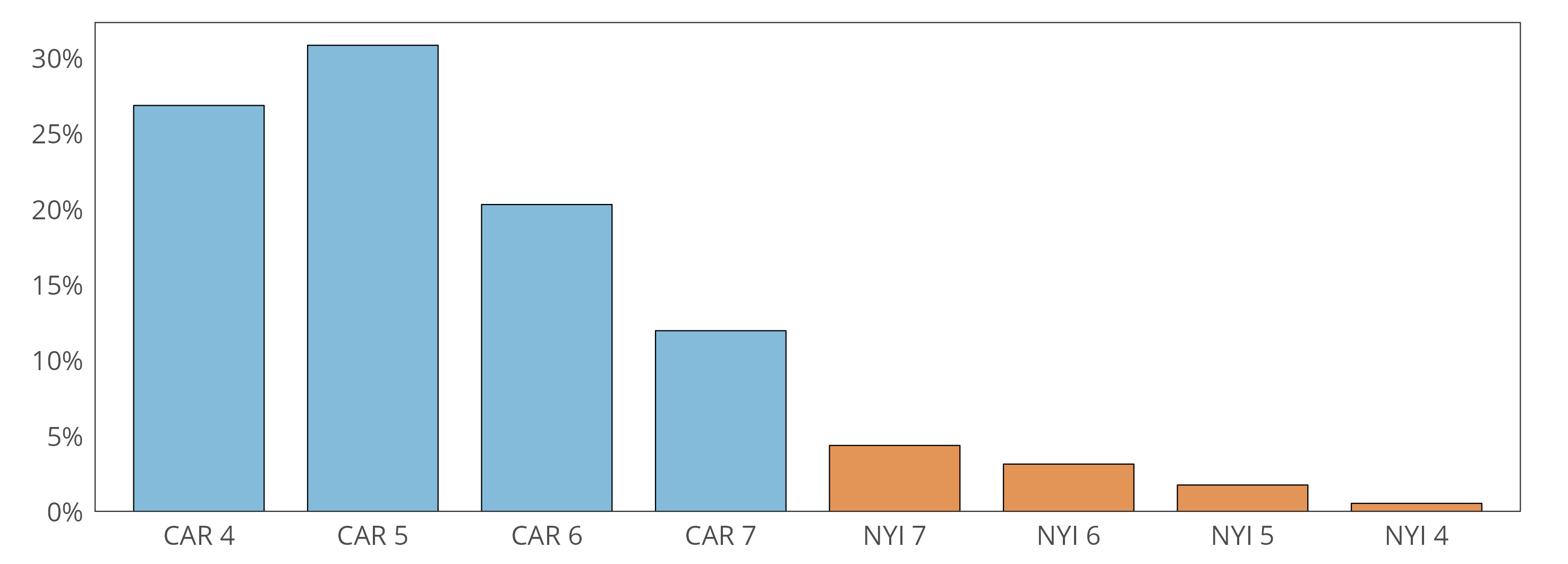
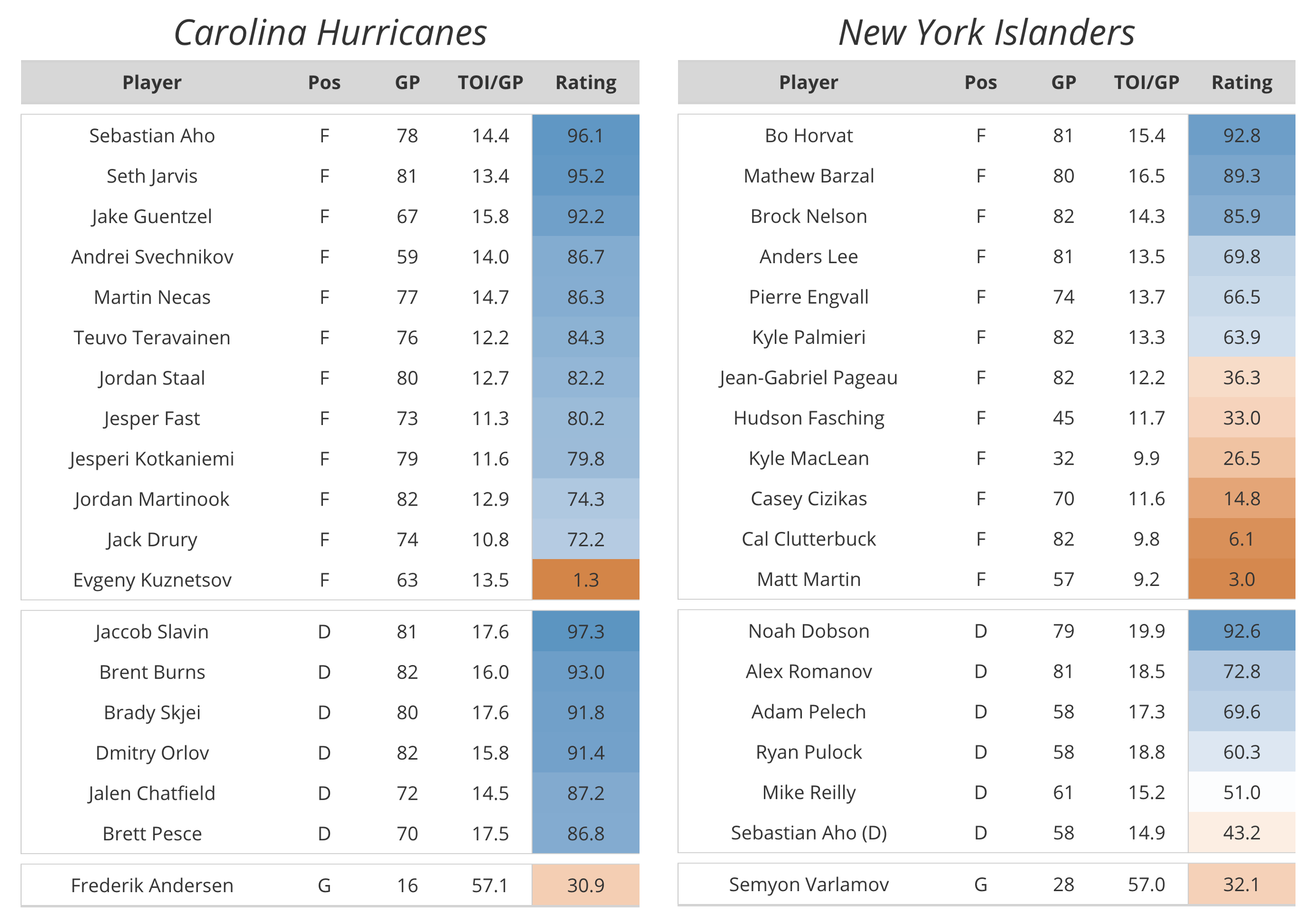
Don Waddell and the Carolina Hurricanes liked their team again this season. Actually, maybe they loved their team because they made some splashes at the trade deadline. Same story, different season. Historically, the Canes have lacked scorers. When you’re playing moneyball, and also drafting fairly low in the first round, it becomes difficult to acquire such players. They acquired Max Pacioretty in the summer of 2022 for future considerations, but an injury ended that bet. This season, with Michael Bunting not fitting in, they were able to flip him to Pittsburgh for pending UFA Jake Guentzel. The winger has played almost exclusively on the top line with Sebastian Aho and Seth Jarvis. It’s been a clear fit as the trio has controlled almost two-thirds of the expected goals when they were on the ice together. Furthermore, while it hasn’t been as clear of a fit, the Hurricanes also took a shot on the skill of Evgeny Kuznetsov. They are very clearly committed to winning this postseason. Same as last year, their journey starts with the New York Islanders.
Strengths: Everything corsi, depth
Weaknesses: Finishing, goaltending
As always, we must ask ourselves, who do the Islanders think they are? They made their way into the playoffs with only 29 regulation wins, and a -13 goal differential once you back out their shootout win and five losses. Regardless, if there is any team whose current form does not match their entire season, it’s them. They are the hottest team heading into the playoffs, going 8-1-1 over their last 10 games. They also made a coaching change in January, hiring Patrick Roy in replacement of Lane Lambert. Since then, the Islanders have a 51.8% share of expected goals at 5v5 and 54.5% share of actual goals. They lack star power, but make up for it by not having a significant amount of ice time taken up by treacherous players. Ok, let’s be real, I suppose there is a significant amount of time here dedicated to said treacherous players. Oh, and they also have a strong goaltending tandem themselves in Ilya Sorokin and Semyon Varlamov. Are they considerably weaker than the Carolina Hurricanes? Yes. But you can start to see the underdog story, especially with how hot they’ve been as of late.
Strengths: Goaltending, hungry dogs run faster
Weaknesses: Star power, UBS reminds me of IBS
Western Conference
Dallas Stars (C1) vs. Vegas Golden Knights (WC2)
78.4% 21.6%
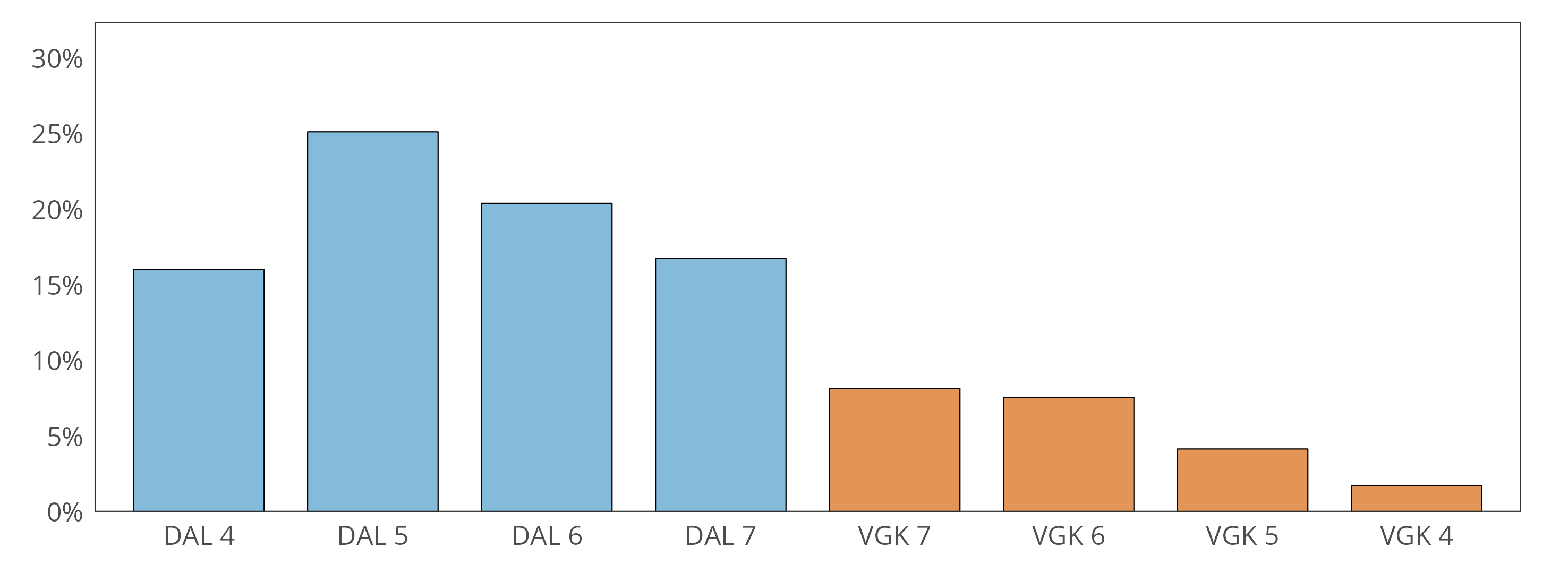

Heading into the regular season, the Stars were considered by most to be one of the strongest teams in the league. And for good reason. They brought back a very similar lineup to the one that made it to the Conference Final last summer. Their very good (yet aging) lineup rewarded them with the second-most points in the league. With the now common-place top line of Robertson, Pavelski, and Hintz, the Stars also found themselves with a new candidate for the best D-pair in the league thanks to Thomas Harley’s breakout season alongside Miro Heiskanen. In addition, they somehow stumbled into one of the best value contracts in the league last summer in Matt Duchene after his buyout from Nashville, and a return to form of sorts from Mason Marchment. If there’s one area of concern for a team that seems to have it all, it’s Jake Oettinger. After averaging nearly 25 GAR a year in his prior three seasons, Oettinger struggled a bit posting only 6.8 GAR in 54 games. Despite this, it’s hard to look past the prior results of such an excellent young goaltender, which our model reflect here. Either way, Dallas may just have the best defensive skater group in the NHL to, at the very least, possibly cover up any goaltending issues. Only four of their regular skaters posted below-replacement EVD per our GAR model, and Robertson is a clear Selke frontrunner. The Dallas Stars kind of have it all, even old age.
Strengths: team defense, the best top-line in hockey
Weaknesses: none (we really like Oettinger, he’ll be fine)
At this point, I think we just have to respect the Golden Knights for all the content. I don’t like this team, none of you like this team, they’re kinda slimy, they get away with everything, and somehow as an expansion team they’ve already won a Cup and have yet to be bad. Kind of like my favorite team the Minnesota Wild except the Wild have never won a Cup and also have been bad. Ok but seriously, this is a strange team in every way that requires some respect for some reason? They brought back a very similar roster to their Cup team from last summer, don’t really have any terrible players, started the season incredibly hot, coasted on that and were bad for a while, and then made some actually good moves at the trade deadline to reignite things? They’re stashing one of our favorite players, Mark Stone, on IR for a first-round return, and have found two very solid options in net with Adin Hill and Logan Thompson splitting time throughout the season. At this point, I don’t know, I just wouldn’t be surprised if this team makes it to the Cup Final again. Because of course that would happen.
Strengths: they’re the Golden Knights and I guess someone decided they deserve it
Weaknesses: I don’t know, they have some somewhere I’m sure of it
Winnipeg Jets (C2) vs. Colorado Avalanche (C3)
43.5% 56.5%
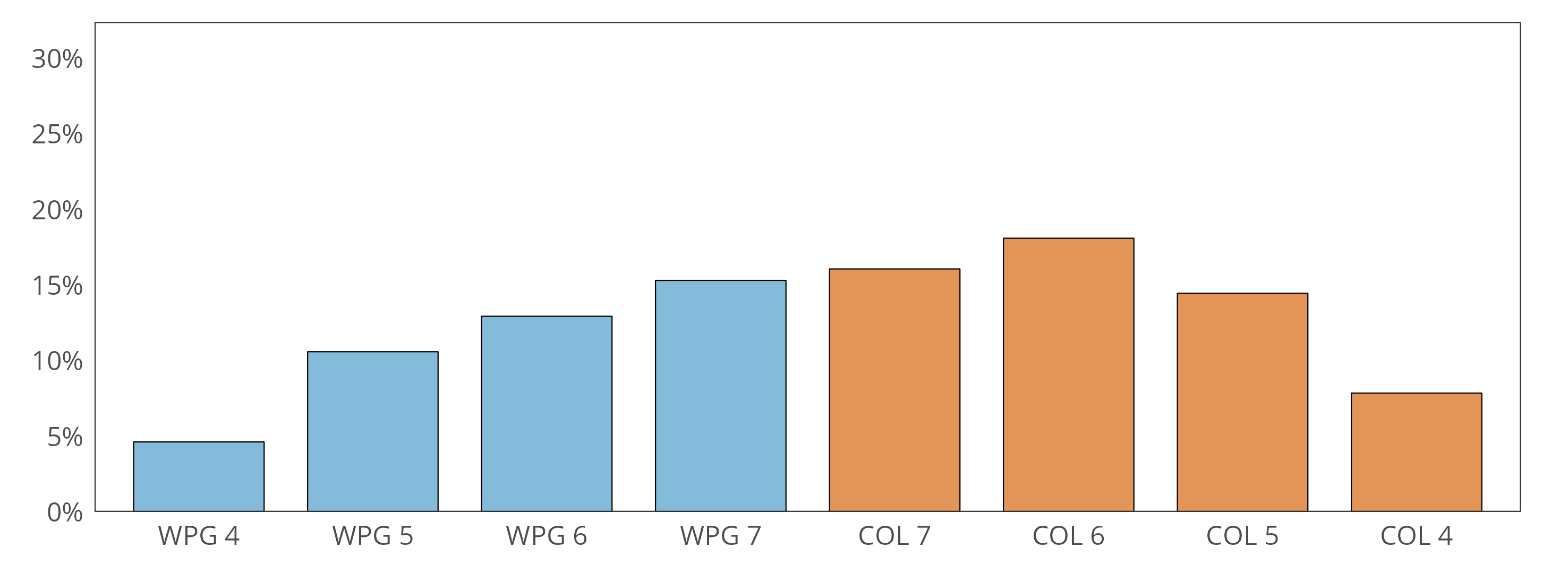
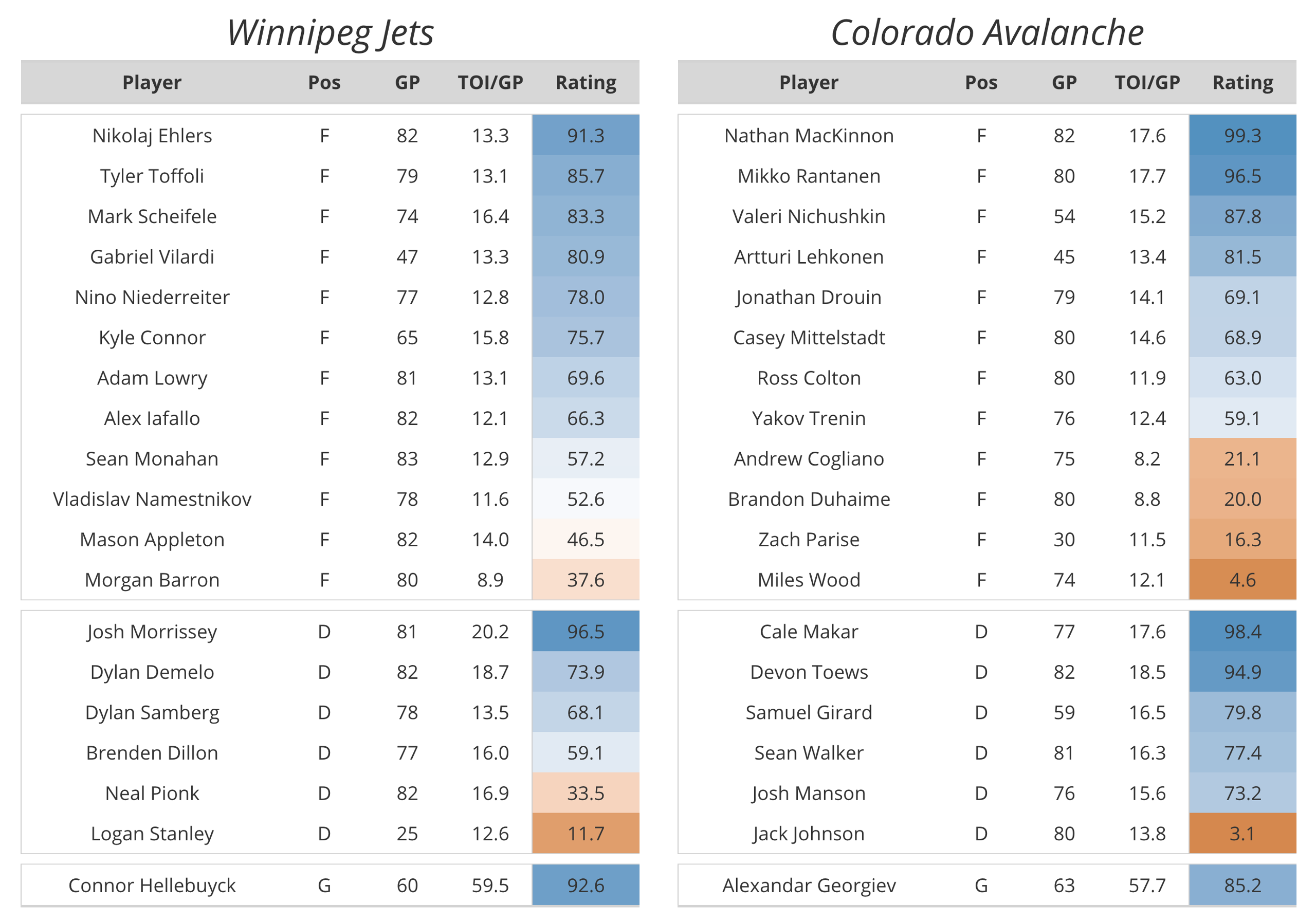
We love the Winnipeg Jets here at Evolving Hockey, at least when comparing our preseason projections to various other public models, of which only the Blackhawks “helped” our model more. Thanks Chicago! The Jets have assembled a surprisingly deep team over the last year or so. Of their regular players, only two skaters finished the season below-replacement in xGAR, and their lineup features numerous “analytics” darlings from years past. The additions of Nino Niederreiter last season, Gabriel Vilardi and Alex Iafallo this past summer, and Sean Monahan a few months ago have paid off substantially. The biggest surprise(s) may be Adam Lowry and Alex Iafallo, who both finished top-10 in xEVD, rounding out very solid bottom-lines for the Jets. Winnipeg’s biggest strength is easily Connor Hellebuyck. At this point I think it’s fair to say we haven’t seen a goalie in the league this consistently good since Henrik Lundqvist. Over the last five seasons, Hellebuyck has amassed ~40 more Goals Above Replacement than the next goalie during this span, which, to put mildly, is insane. The almost-certain Vezina winner will be the clear “question” for the Jets, which is an easy one to answer. The Jets may lack skater “star power”, but they may just match Colorado’s with Hellebuyck.
Strengths: Connor Hellebuyck
Weaknesses: Star power, reliance on depth
The Avalanche keep finding ways to surround their ridiculous skater talent at the top with new pieces to support the team when MacKinnon and company aren’t on the ice. Coloraddo enters the first round with arguably one of the strongest top-two lines in the league, even if these lines have moved around quite a bit over the last 7 months. Easily their biggest advantage is still having a dominant Nathan MacKinnon, who finished 1st in GAR and 2nd in xGAR per our models. Mikko Rantanen and site favorites Valeri Nichushkin and Artturi Lehkonen round out an impressive group at the top. Possibly the most surprising player for Colorado this season has been Jonathan Drouin, who was arguably the team’s second most valuable player by both GAR and xGAR after signing, essentially, a league-minimum one-year contract last summer. Their biggest concern, which may just be every team’s biggest concern, is goaltending. Alexander Georgiev had an unexpected drop in performance compared with last season (only 2.4 GAR in ’23-24 compared to an arguably top-10 season of 28.4 in ’22-23). Either way, the Avalanche enter the first round with more star power than almost any team and an organization that has definitely been there before. Their biggest challenge will be one dude: Connor Hellebuyck.
Strengths: they have MacKinnon and Makar and Toews and …
Weaknesses: Depth, playing against Hellebuyck
Vancouver Canucks (P1) vs. Nashville Predators (WC1)
72.9% 27.1%
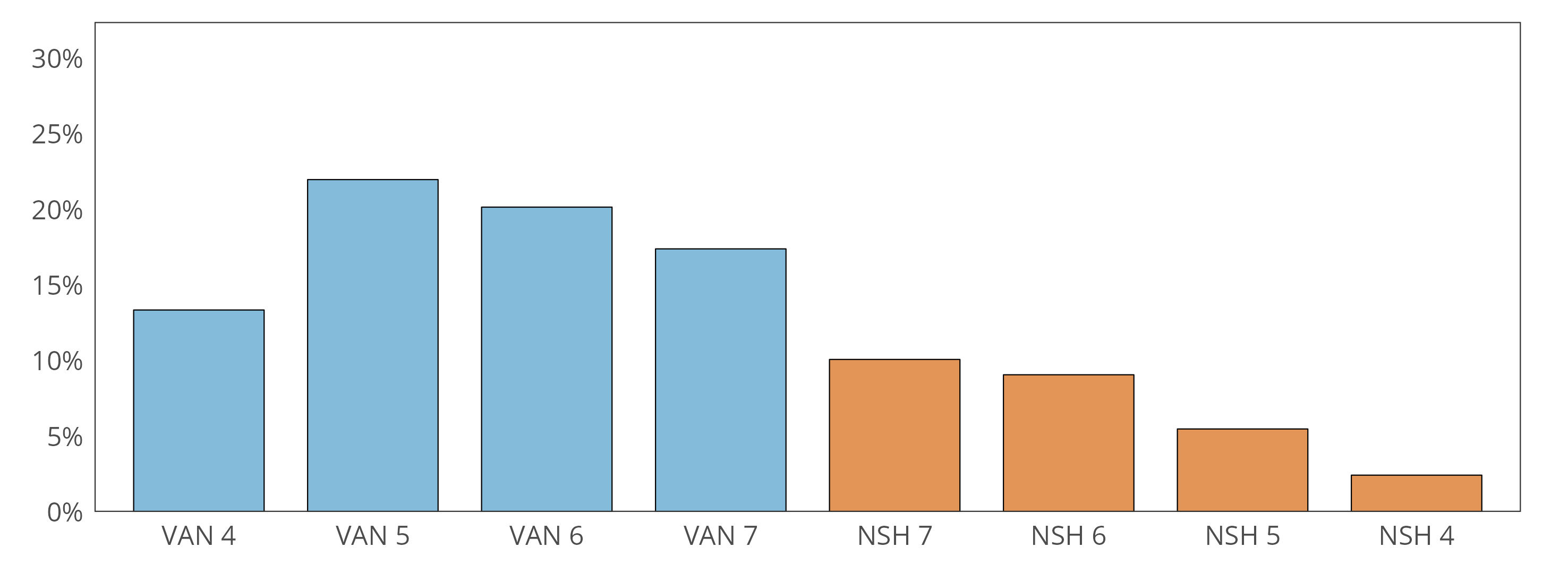
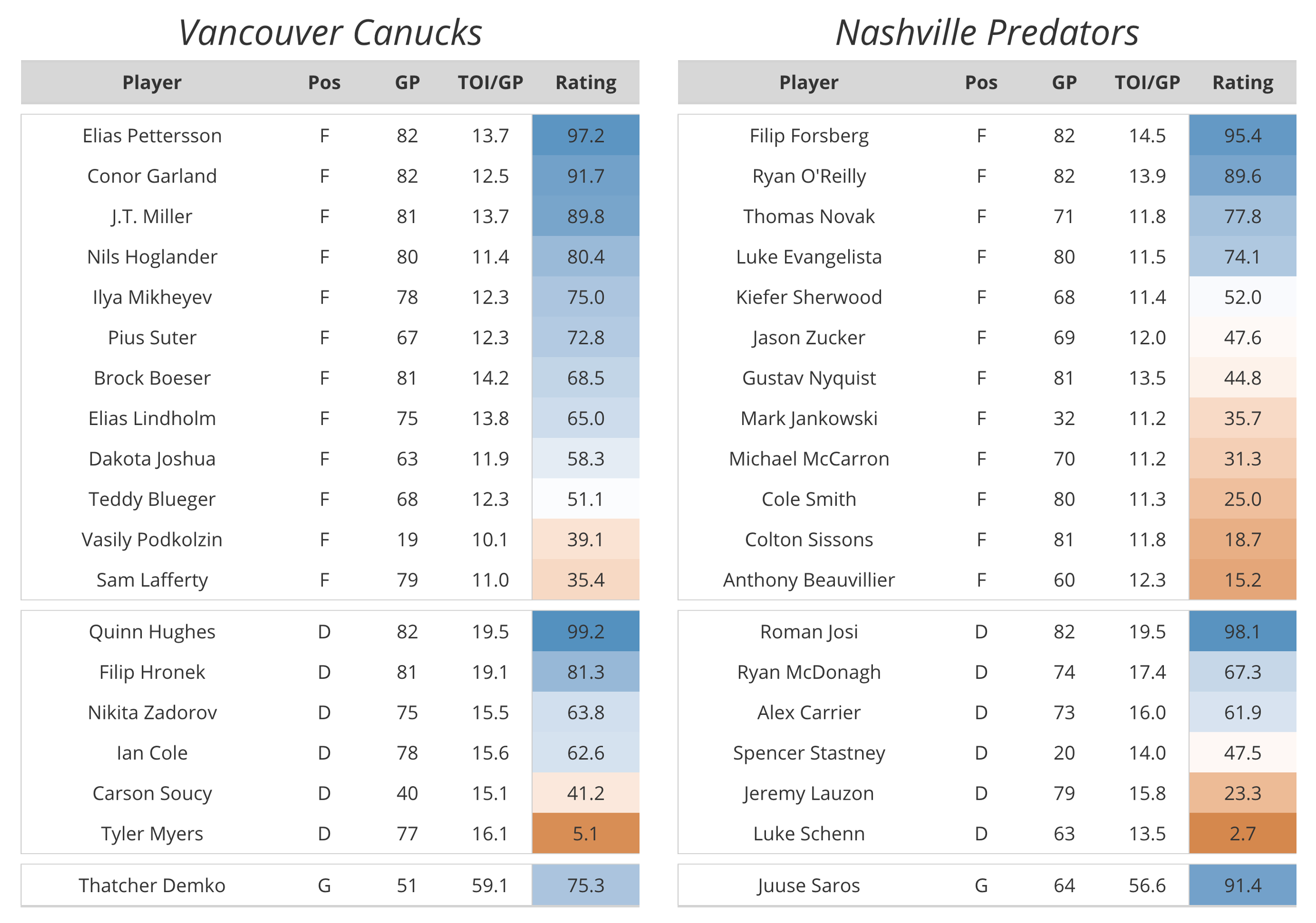
The Vancouver Canucks. The ultimate Cinderella Team. No one believed in them, everyone doubted them, even hated them, but they persevered! I kid, but only a little bit. No team overperformed expectations quite like the Canucks this season; with a final standings total almost 20 points higher than the public models’ average, the Canucks were truly in a league of their own. Sure, a good portion of their early success was the result of ridiculous shooting and save % numbers (their 10-game rolling PDO peaked around 109 at the 34 game mark), but those fell back to league average by the end of the season. While a lot went right for the Canucks this season, they also have a very good team underneath all of that, so that’s expected, right? Several of their skaters were positive in every GAR/xGAR component (Hughes, Pettersson, Garland, even Hoglander was close), and it’s fair to say at the very least Hughes and Pettersson will likely be in the year-end Awards talk. Thatcher Demko returned to form after several years of major injury setbacks, and is now dealing with another injury, albeit one that doesn’t appear to be a major concern heading into the playoffs. Like several teams, the Canucks main issue is their depth. They’re rostering a few questionable players lower in their lineup, and Elias Lindholm’s short time in Vancouver has been less than stellar. Regardless, the Canucks surprised everyone (except Vancouver fans, who have never stopped believing their team is amazing), and head into the first round as heavy favorites.
Strengths: stars, goaltending
Weakness: Tyler Myers, depth issues, injury questions
After missing the playoffs last year, the Predators thought they were still a playoff team heading into ’23-24: they added six players in free agency including Ryan O’Reilly and Gustav Nyquist, re-signed numerous players, and got rid of Alex Galchenyuk and Matt Duchene (the latter may be a regret). Even after all of this, no public model projected them to finish with more than 90 points, essentially projecting another playoff miss. But the Predators were the team in the West that wanted it more than any other team (at least the Wild and Blues, we’re not gonna talk about the Flames or Kraken). Relying heavily on their fantastic top-line of Forsberg, Nyquist, and O’Reilly (who played over 750 minutes together at 5v5 this year), the best season of Roman Josi’s career alongside Ryan McDonagh, and some great scrappy depth performances from the likes of Thomas Novak and rookie Luke Evagelista, the Predators have a surprisingly effective team given their preseason expectations. They’re not a favorite by any means here, and their roster on paper looks very suspect, but it wouldn’t surprise me if the Canucks struggle a bit in this series. Or they could just get absolutely run over. That’s hockey baby!
Strengths: scrappy depth, surprising top line
Weaknesses: roster on paper is pretty bad not gonna lie
Edmonton Oilers (P2) vs. Los Angeles Kings (P3)
71.7% 28.3%
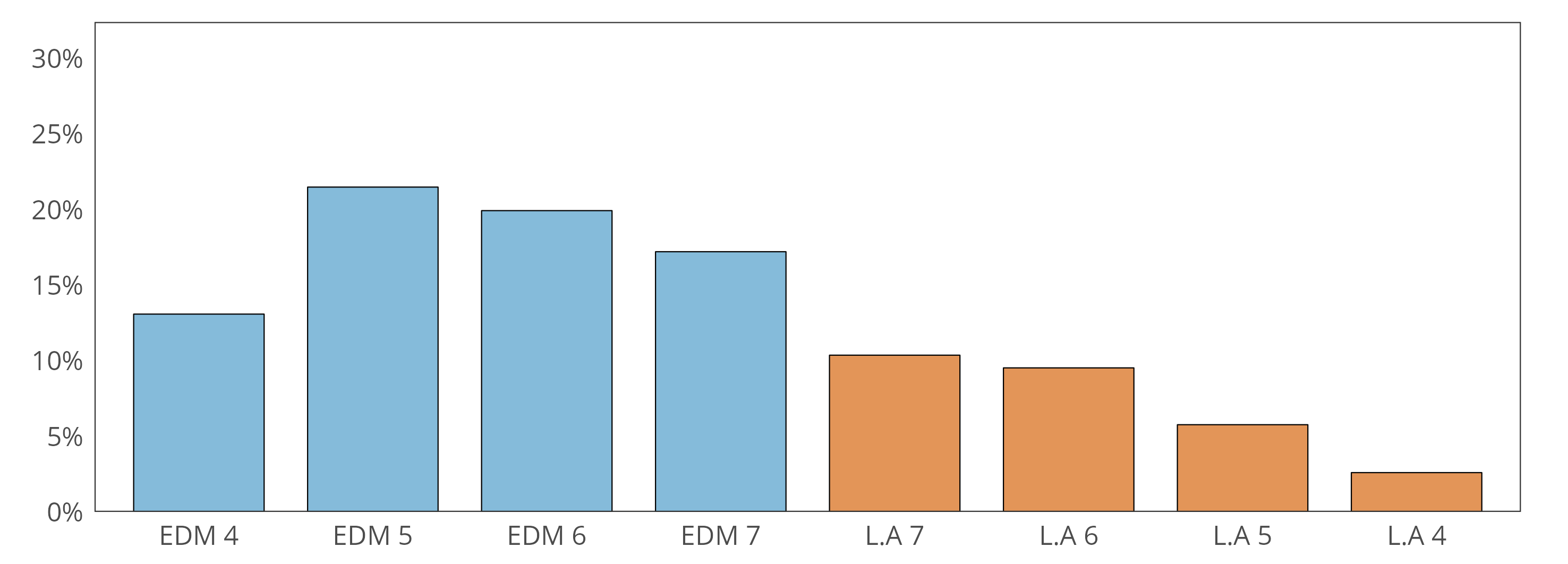
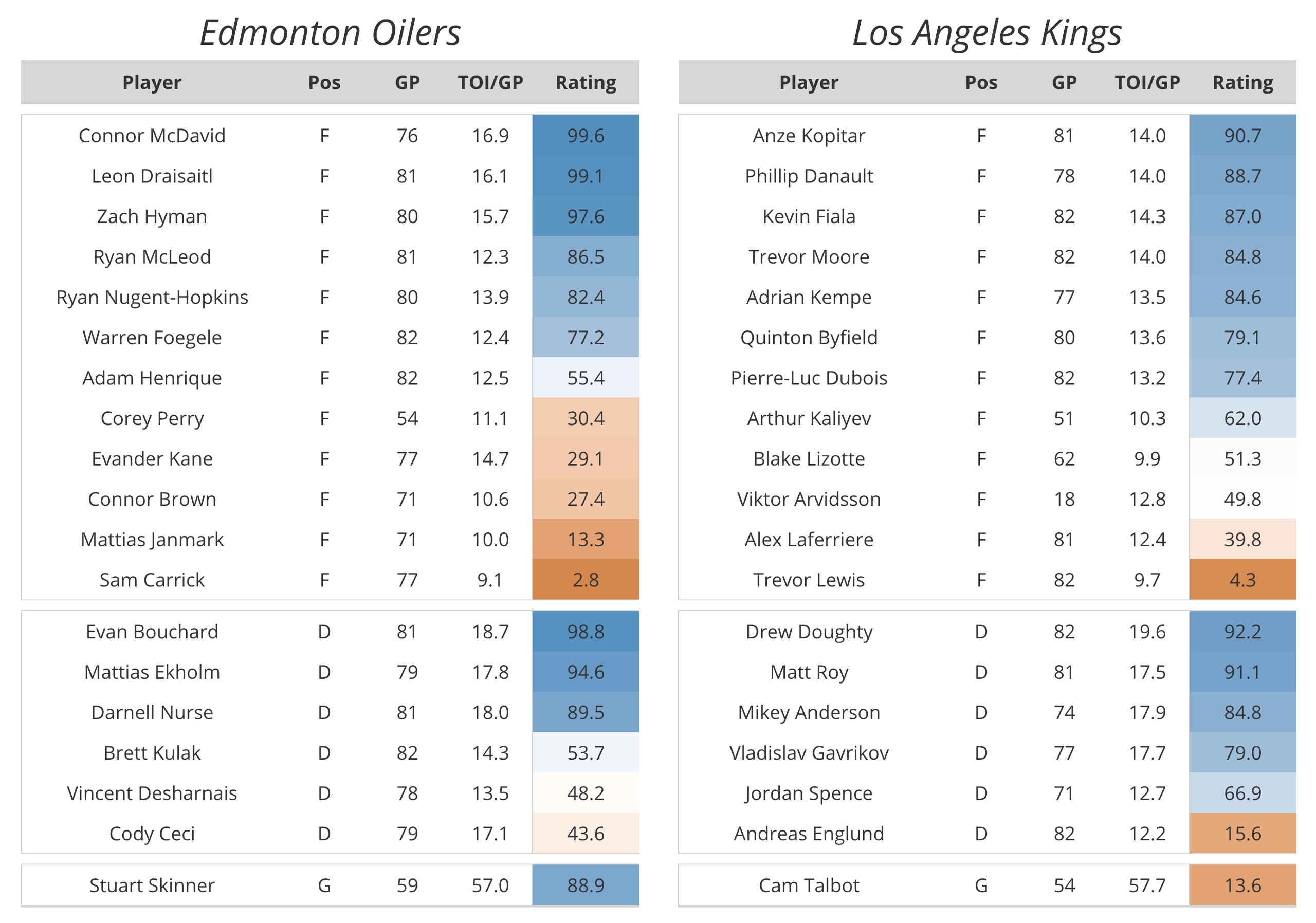
Oilers fans always find a way to be a little irritated with us. Oh, Zach Hyman is slightly above McDavid in our Hart rankings? Oh that’s too bad. Every few years we get a team like this season’s Oilers. After 109 points in the ’22-23 regular season, Edmonton decided to lose 9 of their first 12 games, drop to 31st in the league, and get their coach fired. Ok, maybe it didn’t quite happen like that, but that’s how we’ll all remember it. Stuart Skinner may be the biggest reason for this; after an atrocious start to the season, Skinner completely turned things around, in part leading to a 16-game winning streak during the winter. This year’s Edmonton team is essentially the same as it’s been for years: Connor McDavid and Leon Draisaitl. I’m kind of joking here, but let’s be honest. Surprisingly, Zach Hyman actually led all Oilers skaters in xGAR, and finished 2nd in GAR (behind McDavid). I think there’s some room to question our models’ evaluation of McDavid’s impact on Hyman, but McDavid didn’t score 54 goals (although he did have 100 assists lol). Regardless, with a top-pair of Bouchard and Ekholm that emerged as one of the best defensive duos in this league, very few holes in their depth, the best EV xGF± RAPM in the league, and a resurgent Skinner in net, the Oilers will be one of the favorites coming out of the West. Eventually McDavid gets a Cup, right? Let’s not keep up this Mike Trout nonsense for much longer.
Strengths: Same as it ever was
Weaknesses: They’re the Oilers
The Kings’ hold sole possession of the weirdest season of any team in the league. Through the first 30 games, Los Angeles looked to be a force, carrying the 2nd best EV shot attempt differential in the league (only behind Carolina) after what some thought was a solid offseason. As the season progressed, the Kings saw their dominant even-strength performance slowly shrink back to average. Usually, we see inflated point totals in the first part of a season with unsupported underlying numbers and a fall-off as the season goes along, not the other way around, or something like that. Regardless, the Kings still have a solid team backed by the ageless Anze Kopitar and Drew Doughty (I don’t know how old they are, and I won’t be looking it up). The offseason addition of Gavrikov panned out about as expected, but I’m sure the Kings would rather have Iafallo and Vilardi on their roster in place of Pierre-Luc Dubois at this point. Either way, LA’s biggest strength this season has been 36-year old Cam Talbot, who had his best season since ’16-17 per our goalie GAR model. Talbot is also the biggest point of uncertainty for the Kings here, and our model reflects somewhat harshly here. But, if he can play like he did for most of the season, the Kings may just have a shot. It’ll be tough against two (three?) of the best goal scorers in the game.
Strengths: Underdogs, Kopitar
Weaknesses: A 36 year old questionable goalie, weird consistency
Conclusion
